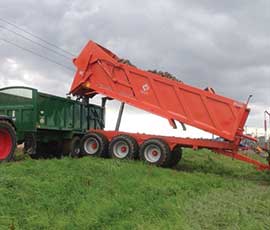Larrington ejector trailer masters mud problem

Last year’s appallingly wet autumn and winter wasn’t just bad for farmers, contractors and hauliers. Local residents who live near beet, maize and potato fields had to put up with a lot of mud, too – despite endless cleaning of trailer wheels, it’s almost impossible to keep trailers clean in such conditions.
In February this year, one group of residents in Yorkshire even barricaded a field entrance where carrot harvesting was going on because they were so fed up with the amount of mud on the road. And that was despite the contractor running a telehandler and brush up and down the road on an almost non-stop basis.
As if that was not enough, the police are increasingly inclined to throw the book at you if you drop mud on a public highway.
Trailer maker Richard Larrington reckons the mud problem could get worse as the acreage of winter-harvested crops such as maize increases. One way to appease local residents, he reckons, is to use cleated tyres to minimise the amount of mud carried off the field (see Farmers Weekly, 19 October, p60).
The other, more radical, way to solve the problem was to come up with the Larrington ejector chaser trailer. This is based on a unit that was first shown at the 2013 Lamma show and turns the traditional rear-pivoting layout of trailers on its head.
The ejector chaser trailer puts the pivot point at the front of the trailer and the ram at the back. At the same time a sealed sliding floor and headboard (powered by a second, horizontal ram) pushes crop up and into the waiting trailer.
The key thing about this layout, points out Mr Larrington, is that it potentially provides the best of both worlds. In a low-roofed barn, the headboard pushes out corn without having to tip the body. Equally it can be converted into a muckspreader.
What’s more cunning is the fact the back of the trailer can lift to discharge a load of beet into a waiting trailer or lorry on a headland or track. That means the same trailers don’t travel on both road and field. Getting the trailer close up to the lorry side sounds tricky, but is made easy by the combination of a tailgate-mounted camera and car-style reversing sensor.
Equally, the rear-pivot layout means you can heap sugar beet 3m high or transfer seed potatoes from farm to planter. Or it can turn into a corn chaser bin to take grain from the combine to waiting lorries or trailers. It could even be used to load mobile driers.
Two- or three-axle steering versions are available, costing £49,950 and £60,000, respectively. Not a cheap option, agrees Mr Larrington, but for farmers growing grain and roots/potatoes it could be a versatile and well-used piece of equipment.

